Menus
- Duel of the generations
- Similarities go much further
- A delightful contrast
- Retro-Four wears a slipper clutch
- Perfect embodiment of Honda’s virtues
- 15 seconds to pull through from 60 to 140 km / h
- The old engine gives more sense of power
- And the 17 incher?
- The Honda CB 1100 F circles corners precisely
- What a great young timer
- MOTORRAD conclusion on the generation duel
- Honda CB through the ages: four-cylinder to fall in love with
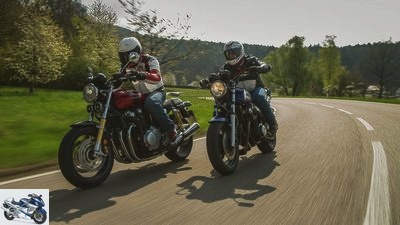
Arturo Rivas
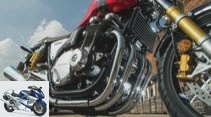
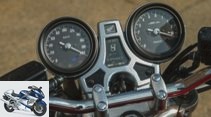
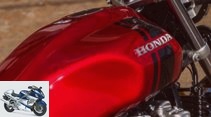
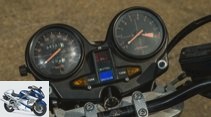
34 photos
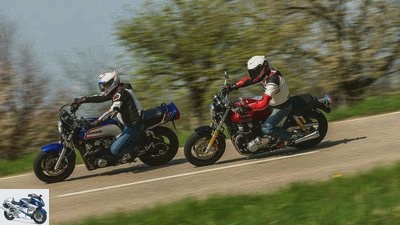
Arturo Rivas
1/34
Honda CB 1100 RS and Bike Side-Honda CB 1100 F in comparison
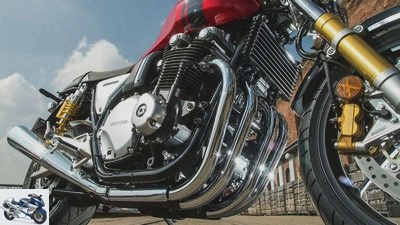
Arturo Rivas
2/34
Glossy: chrome-plated manifolds. Black cylinders, radial brake calipers and golden stanchions as RS insignia (CB 1100 RS 2017)
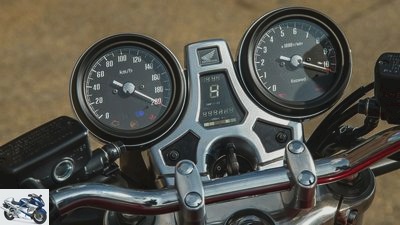
Arturo Rivas
3/34
A feast for the eyes: round instruments with thin needles. Modern: central gear indicator (CB 1100 RS 2017)
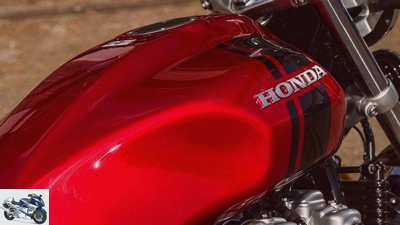
Arturo Rivas
4/34
Redesigned: 16.8 liter tank with longer sides, with the RS with stripe decoration (CB 1100 RS 2017)
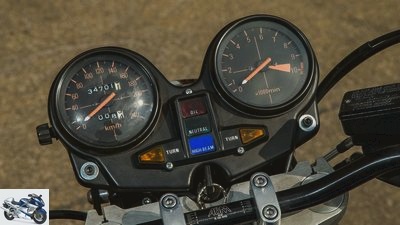
Arturo Rivas
5/34
Classic: large round clocks with thick hands, clearly structured indicator lights (Bike Side-CB 1100 F 1983)
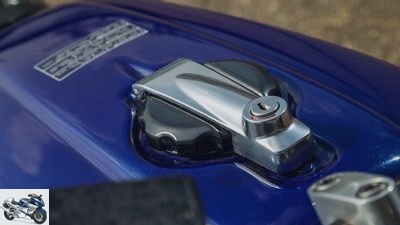
Arturo Rivas
6/34
Small art in metal: the XXL fuel filler cap is kept securely locked (Bike Side-CB 1100 F 1983)
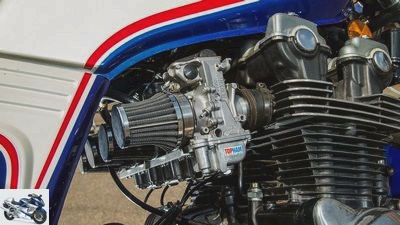
Arturo Rivas
7/34
Cathedral of power: Honda’s typical dohc four-valve engine, here with flat slide carburetors and open air filters (Bike Side-CB 1100 F 1983)
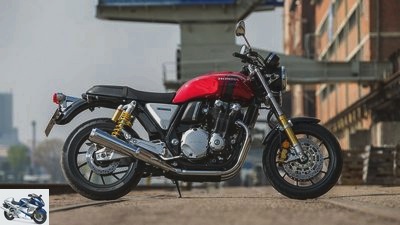
Arturo Rivas
8/34
Crisp: The new RS version has cast wheels, aluminum swingarm, suspension struts with reservoir and a stronger fork.
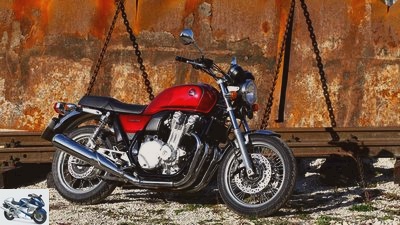
Thomas Schmieder
9/34
Like the 2017 EX it has aluminum side covers and shorter silencers (EX from 2014)
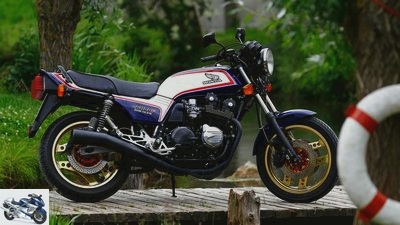
factstudio.de
10/34
Topped: 17-inch wheels, R1 brakes as well as the wheels and forks of a Yamaha XJR 1300 improve the 1100s.
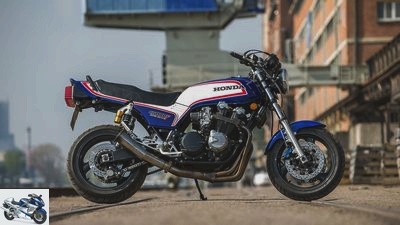
Arturo Rivas
11/34
There are also Ohlins struts, aluminum swingarm and Scheibel exhaust system. Left: the series machine with Comstar wheels
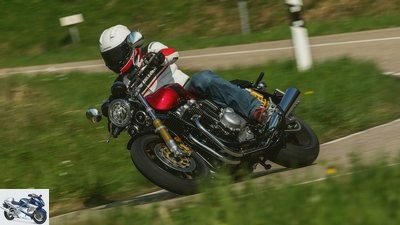
Arturo Rivas
12/34
CB 1100 RS 2017 Curve artist? Yes and no: Despite its 17 incher, the RS is not a handling miracle. In addition, it stands up on bumps
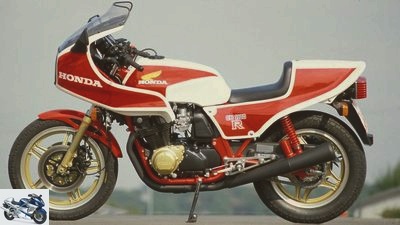
13/34
Noble racer from 1981: CB 1100 R with one-man hump and superbike feeling ex works
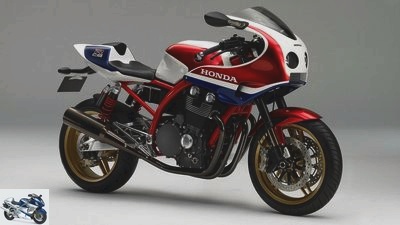
Honda
14/34
Unfortunately, it never went into series production: Study of the beautiful retro racer CB 1100 R (2007)
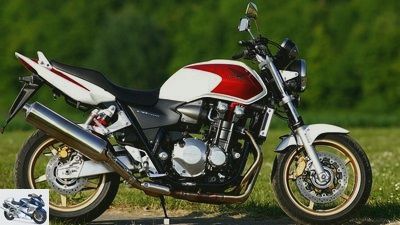
factstudio.de
15/34
Top model: The water-cooled CB 1300 (from 1998) was later also half-covered
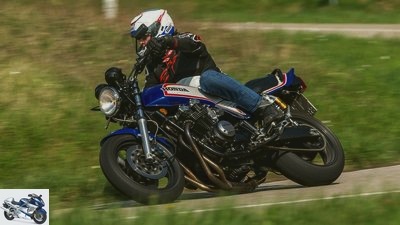
Arturo Rivas
16/34
Bike Side-CB 1100 F 1983; In a class of its own: In corners, the tuned historic Honda stays more neutral on course with great Ohlins suspension elements

Arturo Rivas
17/34
Honda CB 1100 RS and Bike Side-Honda CB 1100 F in comparison
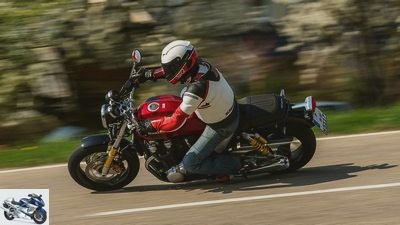
Arturo Rivas
18/34
Honda CB 1100 RS and Bike Side-Honda CB 1100 F in comparison
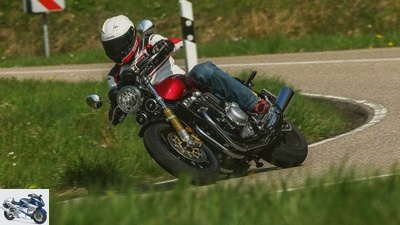
Arturo Rivas
19/34
Honda CB 1100 RS and Bike Side-Honda CB 1100 F in comparison
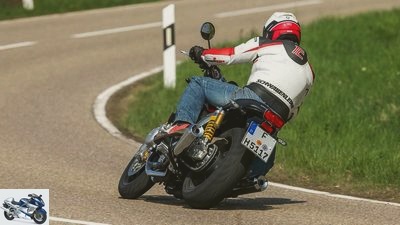
Arturo Rivas
20/34
Honda CB 1100 RS and Bike Side-Honda CB 1100 F in comparison
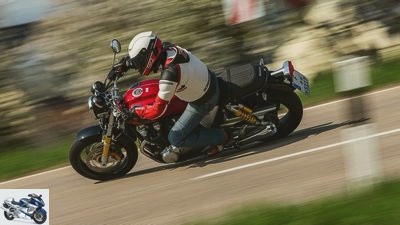
Arturo Rivas
21/34
Honda CB 1100 RS and Bike Side-Honda CB 1100 F in comparison

Arturo Rivas
22/34
Honda CB 1100 RS and Bike Side-Honda CB 1100 F in comparison
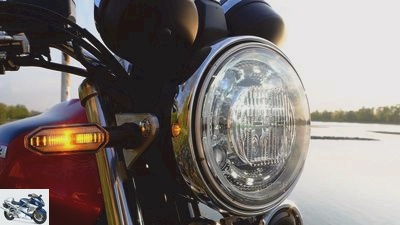
Thomas Schmieder
23/34
Honda CB 1100 RS and Bike Side-Honda CB 1100 F in comparison
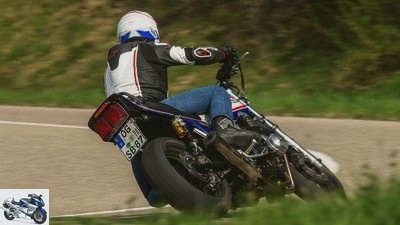
Arturo Rivas
24/34
Honda CB 1100 RS and Bike Side-Honda CB 1100 F in comparison

Arturo Rivas
25/34
Honda CB 1100 RS and Bike Side-Honda CB 1100 F in comparison
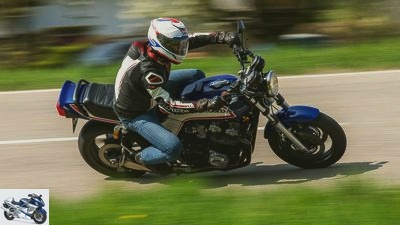
Arturo Rivas
26/34
Honda CB 1100 RS and Bike Side-Honda CB 1100 F in comparison
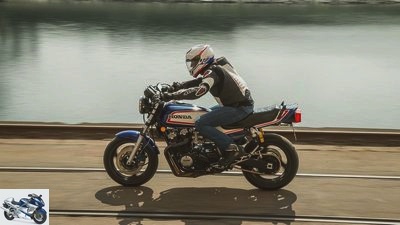
Arturo Rivas
27/34
Honda CB 1100 RS and Bike Side-Honda CB 1100 F in comparison
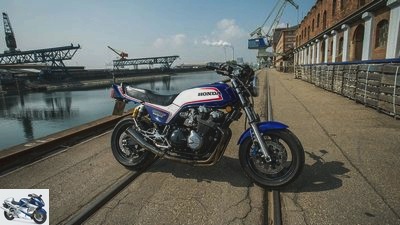
Arturo Rivas
28/34
Honda CB 1100 RS and Bike Side-Honda CB 1100 F in comparison
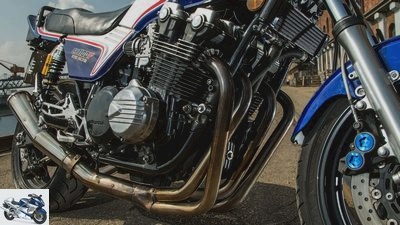
Arturo Rivas
29/34
Honda CB 1100 RS and Bike Side-Honda CB 1100 F in comparison

Arturo Rivas
30/34
Honda CB 1100 RS and Bike Side-Honda CB 1100 F in comparison
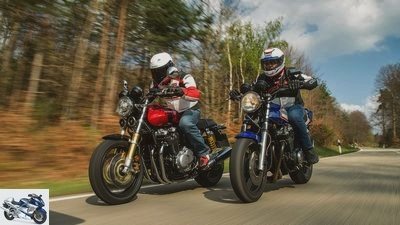
Arturo Rivas
31/34
Honda CB 1100 RS and Bike Side-Honda CB 1100 F in comparison
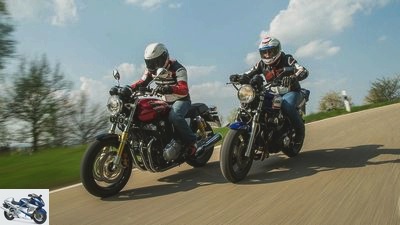
Arturo Rivas
32/34
Honda CB 1100 RS and Bike Side-Honda CB 1100 F in comparison
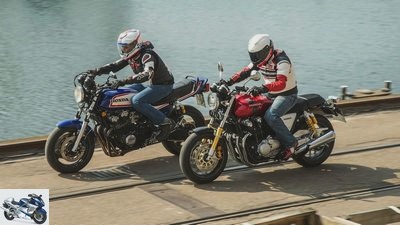
Arturo Rivas
33/34
Honda CB 1100 RS and Bike Side-Honda CB 1100 F in comparison
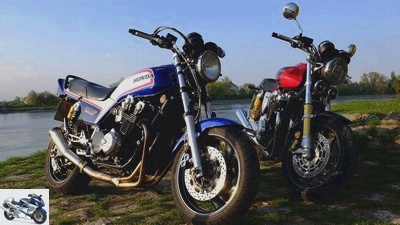
Thomas Schmieder
34/34
Honda CB 1100 RS and Bike Side-Honda CB 1100 F in comparison
Honda CB 1100 RS and Bike Side-Honda CB 1100 F in a comparison test
Duel of the generations
The Honda CB 1100 RS hits the heart. And in this comparison to a historic Honda CB 1100 F, whose chassis was trimmed in a similar direction by Bike Side. A duel between the generations.
Finally spring! Luminous flowers and fresh green leaves adorn bushes and trees, birds sing everywhere. Not only is nature awakening, but also the urge to move forward. A strip of asphalt unrolls in front of and below us, somewhere in the Black Forest, the Eifel or in the Taunus. It is the script for moving moments, for a very personal road movie: dreams are on the road. We drive the new Honda C.B 1100 RS and, so to speak, their ancestor, the Honda CB 1100 F from 1983. Both with large, air-cooled, finely ribbed four-cylinders with double, overhead camshafts in the head, four valves per cylinder and oil cooler.
Buy complete article
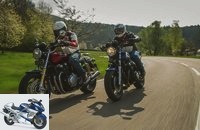
Honda CB 1100 RS and Bike Side-Honda CB 1100 F in a comparison test
Duel of the generations
Video of the Honda comparison test
Similarities go much further
Because while the Honda CB 1100 EX has been rolling on 18-inch wire-spoke wheels with narrow tires since 2014 (110 front, 140 rear), the sportier sister Honda CB 1100 RS relies on 17-inch cast wheels with modern wide tires: 120 / 70-17 and 180 / 55-17. Instead of the 41 telescopic fork of the EX, the RS has a more stable front fork with 43 standpipes and double axle clamps for the large, hollow front axle. Showa is contributing a new fork and yellow RS struts with reservoirs and more progressive winding. The sturdy aluminum swingarm looks noble – the EX, on the other hand, relies on plain tubular steel. Even the RS brakes are better: Golden four-piston calipers bite larger discs (310 instead of 296 millimeters in diameter) and are also struck radially instead of axially.
A delightful contrast
This special Honda CB 1100 F from 1983 also carries such technical highlights. The renowned Baden youngtimer forge Bike Side also refined it with a 43 mm telescopic fork from a Yamaha XJR 1300 instead of the once unstable 39 mm fork. So the ineffective Anti-Dive was thrown onto the rubbish heap of motorcycle history. Just like the struts: they gave way to adapted specimens from Ohlins. Fine Swedish goods also spring inside the fork. Well, and then there are the 17-inch rims with the same tire dimensions as the modern Honda CB 1100 RS. A delightful contrast, isn’t it? That was also the opinion of the owner of the 34-year-old machine, Stephan Brandstetter from Oberkirch, who kindly lent us the motorcycle.
Retro-Four wears a slipper clutch
But before comparing old / new, the list of changes to the Honda CB 1100 model year 2017: Honda has saved the last air / oil-cooled four-cylinder into the Euro 4 era. So there was new software for RS and EX, shorter and thinner silencers, as well as side covers and chain guards made of brushed aluminum. Now the Retro-Four has an anti-hopping clutch to prevent rear wheel stamping as well as LED round headlights and rear lights. The Honda CB 1100 RS even flashes diodes. All new features are rounded off by the new 16.8 liter instead of 17.5 liter steel tank with an embedded fuel cap and Honda logo. It is welded without folded seams, so it should look more authentic. The RS tank is adorned with a “sporty stripe look”. Only it wears the cylinders coated in black – just like the Honda CB 1100 F. Well, the classic design comes naturally with the classic design thanks to the characteristic three-color paintwork. And after the Rosskur at Bike Side also an aluminum swing arm. It comes from a Yamaha FZR 1000 and was modified by Klaus Dony, boss of Bike Side, to accommodate stereo struts.
Perfect embodiment of Honda’s virtues
So go ahead! The current four-in-a-row bubbles nicely, whispers sonorous and socially acceptable. With a full 1,140 cm3 displacement, you don’t need to prove anything. The short-stroke injection engine sounds full and well muffled. Fine. The old mallet, which is square in stroke to bore, makes no secret of its superbike past. Wow, how that rattles, babbles and roars from the retrofitted 4-in-1 Scheibel stainless steel exhaust system, wonderful – for fans. This particular Honda CB 1100 F sounds like it looks: horny. You hear the Mikuni RS flat slide rattle in their guides. The carburettors hang fine on the gas. Klaus Dony has them entered just like the open funnels. Slight resistance when the gas is drawn out from rolling phases is part of it. In contrast, the Honda CB 1100 RS, sporty spirit or not, looks much smoother, in a positive way, smoother. Gentle throttle response, hydraulic clutch, shifting in the perfectly locking six-speed gearbox – everything is user-friendly, buttery smooth. It is the perfect embodiment of Honda’s virtues. But also of always prevailing caution: At a real speed of 180 is always electronically locked – only the third gear turns up to over 7,000 tours, lifts 91 hp at 7,300 / min.
15 seconds to pull through from 60 to 140 km / h
But gears four, five and above all six are speed-limited. In the sixth, only 69 hp are achieved at 5,300 tours. Such games were neither known nor possible in 1983, when the 1062 cubic racer was still running well over 200 things. Why so modest? Do chassis and frame structures (steel tubes here and there) work worse today than they did 35 years ago? When accelerating from a standstill, the 100-horsepower oldie also comes out of the push a little better. Well, it has been slimmed down to 240 kilograms – a full 24 kilograms less than standard and 16 kilograms lighter than the RS. The new 1100 looks more delicate, but is heavier. As if that weren’t enough, the historic Honda is ahead of the curve in the final fifth gear compared to the overdrive of the current 1100 series. 15 seconds to pull through from 60 to 140 km / h have the speed of a VW Polo. If you want to be a little quick on the RS, you have to shift down one or two gears before overtaking. No wonder: at 100 kilometers an hour, the Honda CB 1100 RS’s overdrive gear doesn’t even hit the 3,000 mark, in the fifth it is just a little over 3,000 tours.
The old engine gives more sense of power
On the other hand, the F already has around 4,500 revolutions. Ultimately, the old engine gives a more sense of power. The current Honda CB 1100 RS, on the other hand, stands for personified gentleness and, with its power-to-weight ratio, is much closer to the CB 900 F Bol d’Or than to the 1100 Super Bol d’Or. And stayed true to the calm, unexcited character of the spoke wheel EX, is a good and good-natured glider. Calm and serenity are the strengths of the new Honda. Their essence is quickly transferred to the driver. Enjoy the flow: the meters simply run more slowly under the wheels. In a dignified way, this frees you, almost frees you from constraints. Does the modified chassis fit? Yes, because the new spring elements work synchronously at the front and rear and are thickly dampened. Getting the struts to bottom out at the rear is impossible. With a lot of progression and a strong pressure level, they press the new, fat aluminum swing arm fully against the ground, offering reserves. But the Ohlins goods of the Bike Side Honda CB 1100 F can do it even better, responding super-sensitively to unevenness in the relief.
And the 17 incher?
Well, on the one hand they make them more manageable thanks to their smaller gyroscopic forces and lower weight than spoke wheels, on the other hand wider tires need more lean angle at the same speed than the narrow skins from sister EX. Opposite it, the Honda CB 1100 RS has its steering head a degree steeper and has a caster of almost 100 millimeters (Bike Side does not fall below this value from experience). Nevertheless, the RS is not a handling miracle, but it is never stubborn either. It precisely rewards honest work on the chrome-plated tubular handlebar with reliable turning.
The Honda CB 1100 F circles corners precisely
But when the asphalt throws waves and pustules, the RS with Dunlop Roadsmart III tires stands up powerfully. Then she needs an energetic hand to stay on course. This effect is already noticeable when you take a brisk, committed turn in the city – the modern 1100 series follows long gullies. The tuning classic with well-functioning Bridgestone T 30 on XJR 1300 rims remains more neutral. The tires are easy to grip and roll around to inspire confidence. The Honda CB 1100 F circles curves of all radii very precisely and predictably, stays on course, drives handy and agile. Bike Side is familiar with classic chassis, Klaus Dony drives classic endurance races. With both Hondas, 17-inch standard formats also allow experiments with many tire alternatives. Even with the T 30, the “F” is a bit more manageable and sporty. The Honda CB 1100 RS touches down much earlier, and with its fearful nipples it creates furrows in the asphalt. The downside of the F’s much higher footrests is its significantly narrower knee angle, despite the stately 84 centimeters seat height. Behind the wide ABM Superbike handlebars on modified triple clamps there is a pure Kenny Roberts feeling.
What a great young timer
Typically Honda: the Honda CB 1100 RS integrates both large and small drivers equally well into the action, the new tank offers more space thanks to longer indentations. Finely adjustable brakes catch the modern machine safely at any time. In 1983, nobody even dared to dream of their finely regulating ABS. But also not from the famous four-piston stoppers of the R1 with different sized brake piston pairs on the Bike Side-1100. What a great youngtimer: this modified oldie can really do something. In contrast, the standard Honda CB 1100 RS acts and makes it more casual. In addition, it offers fine details to be admired: The oil sight glass with “windshield wiper”, for example, an heirloom of the CB 1300, which once donated the shortened engine. There is also the fine, 81 centimeter low bench with a classic strap, hand lever adjustable on both sides, angle valves, luggage hook and helmet lock. Everything is almost like it used to be. And when the cooling fins of both of them crackle in the evening, then that day was simply your friend.
MOTORRAD conclusion on the generation duel
Honda adheres to the construction principle that once made the Japanese big and strong: the air-cooled four-cylinder. The Honda CB 1100 RS is not a modern Honda CBF 1100 F, not an athlete, but a classic naked bike. Relaxation, not speed, is their credo. Compliments for how modern and active the CB 1100 F, tuned by Bike Side, is: Great, Bol d’Or! Originally she was rather weak on her feet.
Honda CB through the ages: four-cylinder to fall in love with
When looking into the future of the CB 1100 RS, a look back at Honda’s glorious past helps. Since 1969, these have shaped epoch-making, originally always air-cooled four-cylinders in king-size format. We bow in gratitude!
archive
Noble racer from 1981: CB 1100 R with one-man hump and superbike feeling ex works.
For the first time, the letter combination “CB” officially adorned the two-cylinder Honda CB 92 Benly in 1959. The abbreviation is said to be derived from CluBman Race, which was held on Honda‘s own racing circuit in Suzuka from 1958. It became a legend from 1969 at the latest with the four-cylinder CB 750 Four motorcycle of the century. “The CB model name has always meant a lot to the world’s largest manufacturer and its customers,” says Honda today full-bodied. The legendary 900 Bol d’Or with four-valve four-cylinder also had this type designation in 1978: CB 900 F. Its basic construction was the inspiration for the sleek superbike CB 1100 R from 1980 – openly full 115 hp from 1062 cm3, ennobled with a one-man hump, first half fairing, then full fairing and golden Comstar wheels.
Honda
Unfortunately, it never went into series production: Study of the beautiful retro racer CB 1100 R (2007).
It was followed in 1983 by the naked Honda CB 1100 F, before Honda relied on water-cooled V4 engines for Big Bikes. But in-line four-cylinder engines also continued to grow, big and powerful, in the form of the CB 1000 Big One presented in autumn 1992. It shone with its water-cooled engine and literally with its attention to detail, lots of the finest parts and excellent paint quality. The CB 1300 was based on it from 1998 onwards. In terms of driving, it was a really great success, especially as a half-faired version it made a 1A all-rounder: Powerful, cultivated and balanced, the CB 1300 S won the 2009 Alpine Masters, and impressed among 20 motorcycles in Alpine Conditions not least because of great brakes – noble, chic and good.
factstudio.de
Top model: The water-cooled CB 1300 (from 1998) was later also half-covered.
As a tribute to Honda’s history, the study of a modern, air-cooled CB 1100 R continued in 2007. It seductively merged the past and a glimpse into a possible future. Unfortunately, Honda could never decide to go into series production. The naked CB 1100, which appeared in 2010 instead, was much more upright, both in design and in appearance. 90 HP, also throttled gear-specific, were no longer a crowning achievement in 1980. From 2013 the Honda CB 1100 also came to Europe, since 2014 with classically beautiful wire-spoke wheels in the EX version, in homage to the CB 750 Four.
Related articles
-
Comparison test Honda CB 1300 S, Suzuki Bandit 1200 S, Yamaha FZ1 Fazer
Bilski comparison test Honda CB 1300 S, Suzuki Bandit 1200 S, Yamaha FZ1 Fazer search for traces They have sporty roots in common. At the Honda in …
-
BMW R 1200 R, Honda CB 1000 R and MV Agusta Brutale 800 in a comparison test
Rivas 18 pictures Arturo Rivas 1/18 picture gallery: Comparison of middle class Nakeds. BMW R 1200 R, Honda CB 1000 R, MV Agusta Bruale 800. Arturo Rivas 2/18 …
-
Driving report: the retro bike Honda CB 1100
Yamada 12 pictures Yamada 1/12 The flap in the exhaust of the Honda CB 1100 is also state-of-the-art. Yamada 2/12 Classic and yet …
-
Cruiser comparison test: Honda VTX 1300 S, Kawasaki VN 1600 Classic
Cruiser comparison test: Honda VTX 1300 S, Kawasaki VN 1600 Classic Damn long and heavy Handy six-centimeter chunks, wheelbases begging for parking bay, …
-
BMW R nineT, Moto Guzzi Griso 1200, Yamaha XJR 1300 and Honda CB 1100 in comparison
www. 38 pictures www. 1/38 What an eerie attraction the BMW R nineT, Moto Guzzi Griso, Yamaha XJR 1300 and Honda CB 1100 …
-
Aprilia Tuono V4 1100 RR, Kawasaki Ninja H2 and BMW S 1000 XR in the comparison test
Arturo Rivas Gonzalez 31 photos Arturo Rivas Gonzalez 1/31 Aprilia Tuono V4 1100 RR, Kawasaki Ninja H2 and BMW S 1000 XR. Arturo Rivas Gonzalez 2/31 And…
-
Comparison test BMW K 1200 GT, Honda Pan European, Yamaha FJR 1300 A
Gargolov comparison test BMW K 1200 GT, Honda Pan European, Yamaha FJR 1300 A Flying Dutchmen The opportunity has never been better: three express tourers …
-
Test BMW R 1100 S against Honda VTR 1000 F
Honda VTR 1000 F Fire Storm Comparison test, BMW R 1100 S, Honda VTR 1000 F Firestorm BMW R 1100 S versus Honda VTR 1000 F “The R 1100 S is not a super…
-
fact Concept comparison Honda CBR 1100 XX Kawasaki ZX-12 R Suzuki GSX-R 1000 Suzuki GSX 1400 Yamaha FZS 1000 Fazer Yamaha FJR 1300 Six bombs The six …
-
Honda CB 1100 and MV Agusta Brutale 1090 in the test
Jahn 35 pictures Jahn 1/35 Two bikes, two worlds. We celebrate diversity and feel the sportiness. Jahn 2/35 Ducati Streetfighter. Jahn 3/35 …